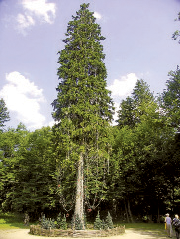At the end of last year, the highest New Year tree of Europe which grew in the Belovezhskaya Pushcha, lavishly celebrated its last jubilee — the 150th anniversary. This summer needles turned yellow and started to fall off. The fir-tree has been sawed down recently.
 It is impossible to call this 40-metre beauty the oldest fir-tree in the Pushcha. There are older trees — 200-year-old. However, a fir-tree around which people and children sang and danced in the Father Frost’s estate during 10 years, had a bad luck. It dried out.
It is impossible to call this 40-metre beauty the oldest fir-tree in the Pushcha. There are older trees — 200-year-old. However, a fir-tree around which people and children sang and danced in the Father Frost’s estate during 10 years, had a bad luck. It dried out.The Director of the National park Belovezhskaya Pushcha, Alexander Bury promises that by the winter there will be a new New Year tree, “It was rather old tree. It dried out because of age. The heat will decline, and we will plant a new fir-tree in Father Frost’s estate. It will be not less beautiful. It is only necessary to wait a little.”
The workers of the national park said that last year was unfavourable for fir forest, and present year is not better. The European spruce bark beetle spread. However, scientists consider that outbreak of mass spreading of pest is not critical. Intensity of drying of fir is lower, than in 1960 when the destruction of fir groves was provoked by reclamation of adjoining bogs. And it cannot be compared with the outbreak at the beginning of 2000, when after dry years with low amount of precipitation, the quarter of all Pushcha forests suffered from European spruce bark beetle.
However, it is impossible to blame forest pests of all troubles of old trees. Tourists are also guilty. A sad picture which I recently saw with own eyes: trunks of the oldest Pushcha’s oak which is 600 years old, and the oldest pine (350 years) were scraped out. It appeared that cycle tourists cut off them for souvenirs.
When workers started to actively develop tourism, some guides attracted people with tales that oak gives man’s force, while pine — woman’s. For some time employees of the National park even scattered the delivered bark around oak and pine, then fenced off the trees.











